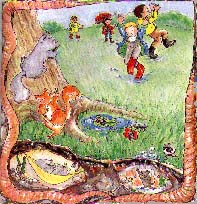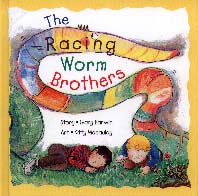|
________________
CM . . . . Volume V Number 16 . . . . April 9, 1999
excerpt: ...Ryan suggested that they have a worm race. He drew a starting line near the swings.  Brothers Aaron and Ryan, who are unable to own traditional pets because of
Aaron's allergies, adopt two backyard worms as pets. They sing to them,
pat them and give them rides on swings and bicycles, but, when they
release them for a race, the worms disappear. The boys, undaunted, assume
Pinky and Worm are continuing to race underground. They draw a helpful map
of the neighborhood, which they move each day, believing the worms consult
it at night. There is no further sign of the worms all summer, yet the
boys imagine the worms are making their way underground to the finish
line. Their patience is rewarded on the first rainy day of school when,
waiting to cross the street, they spy two worms at the stop sign. Deciding
a winner cannot be determined, the boys cheerfully bring their 'pets' to
school where they are met with a less than enthusiastic response from
their teachers.
Brothers Aaron and Ryan, who are unable to own traditional pets because of
Aaron's allergies, adopt two backyard worms as pets. They sing to them,
pat them and give them rides on swings and bicycles, but, when they
release them for a race, the worms disappear. The boys, undaunted, assume
Pinky and Worm are continuing to race underground. They draw a helpful map
of the neighborhood, which they move each day, believing the worms consult
it at night. There is no further sign of the worms all summer, yet the
boys imagine the worms are making their way underground to the finish
line. Their patience is rewarded on the first rainy day of school when,
waiting to cross the street, they spy two worms at the stop sign. Deciding
a winner cannot be determined, the boys cheerfully bring their 'pets' to
school where they are met with a less than enthusiastic response from
their teachers.
That children imbue both animate and inanimate objects with human characteristics is undeniable and that two brothers, thwarted by allergies, would choose worms for pets is completely credible. That they would maintain the competition for a whole summer, despite the participation of the worms is, however, quite unlikely. Whether the worms found in September are the original worms is open to interpretation, as both times Barwin uses the same adjectives with an indefinite article, eg. "a short, fat worm. Regardless, the boys' anticipation is infectious, and Macaulay's illustrations engaging. Energetic and childlike, the pictures match the text and provide additional humour. Not only does she give the worms comical expressions, but also depicts a busy, underground anthropomorphic world. I should note a glaring mistake on the first page. The second line reads: "Any other pet would sneeze and break out in bumps because Aaron was allergic." This caused great amusement to the child with whom I shared the book, at the thought of Aaron causing animals to sneeze and break into hives! Because of the male protagonists and subject matter, this lighthearted story will undoubtedly appeal more to boys, or to any child who has indulged in backyard worm or (in my neighbourhood) snail races. Recommended. Alison Mews is the Coordinator of the Centre for Instructional Services in the Faculty of Education at Memorial University of Newfoundland, St. John's, NF.
To comment on this
title or this review, send mail to cm@umanitoba.ca.
Copyright © the Manitoba Library Association.
Reproduction for personal use is permitted only if this copyright notice
is maintained. Any other reproduction is prohibited without
permission.
Published by
TABLE OF CONTENTS FOR THIS ISSUE - APRIL 9,
1999.
SEARCH |
AUTHORS |
TITLES |
MULTIMEDIA |
PROFILES |
BACK ISSUES |
CMARCHIVE |
HOME
|

